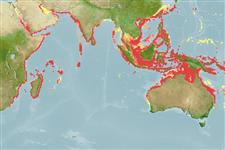>
Eupercaria/misc (Various families in series Eupercaria) >
Haemulidae (Grunts) > Plectorhinchinae
Etymology: Plectorhinchus: Greek, plektos = plaited + Greek, rhyngchos = snout (Ref. 45335).
More on author: Forsskål.
Issue
This species appears to be restricted to southeast Africa to the Arabian Sea, including the Red Sea and Persian Gulf. Junior synonyms Plectorhinchus unicolor (Macleay, 1883) and Plectorhinchus griseus (Cuvier, 1830) are considered valid according to Johnson et al., 2015 (Ref. 103290). Species record and information will be repaired accordingly.
Environment: milieu / climate zone / depth range / distribution range
Écologie
marin; saumâtre récifal; profondeur 0 - 80 m (Ref. 9710). Tropical; 30°N - 32°S, 29°E - 160°E
Indo-West Pacific: eastern Africa south to Port St. Johns, South Africa and east to the western Pacific.
Taille / Poids / Âge
Maturity: Lm ? range ? - ? cm
Max length : 80.0 cm TL mâle / non sexé; (Ref. 9710); common length : 60.0 cm TL mâle / non sexé; (Ref. 5450)
Found around rocks and corals from the surf zone to a depth of 80 m (Ref. 2799). Enters estuaries and rivers in Seychelles, Madagascar and South Africa (Ref. 2135). Juveniles occur in tide pools (Ref. 9710).
Life cycle and mating behavior
Maturité | Reproduction | Frai | Œufs | Fécondité | Larves
Oviparous, distinct pairing during breeding (Ref. 205).
Masuda, H., K. Amaoka, C. Araga, T. Uyeno and T. Yoshino, 1984. The fishes of the Japanese Archipelago. Vol. 1. Tokai University Press, Tokyo, Japan. 437 p. (text). (Ref. 559)
Statut dans la liste rouge de l'IUCN (Ref. 130435: Version 2024-2)
Menace pour l'homme
Harmless
Utilisations par l'homme
Pêcheries: commercial; pêche sportive: oui
Outils
Articles particuliers
Télécharger en XML
Sources Internet
Estimates based on models
Preferred temperature (Ref.
123201): 24.3 - 29, mean 27.9 °C (based on 1644 cells).
Phylogenetic diversity index (Ref.
82804): PD
50 = 0.5000 [Uniqueness, from 0.5 = low to 2.0 = high].
Bayesian length-weight: a=0.01413 (0.00689 - 0.02895), b=3.00 (2.83 - 3.17), in cm total length, based on LWR estimates for this Genus-body shape (Ref.
93245).
Niveau trophique (Ref.
69278): 3.8 ±0.49 se; based on food items.
Résilience (Ref.
120179): Faible, temps minimum de doublement de population : 4,5 à 14 années (Preliminary K or Fecundity.).
Fishing Vulnerability (Ref.
59153): Moderate to high vulnerability (52 of 100).
Climate Vulnerability (Ref.
125649): High to very high vulnerability (74 of 100).
Nutrients (Ref.
124155): Calcium = 23.7 [8.4, 46.1] mg/100g; Iron = 0.46 [0.24, 0.82] mg/100g; Protein = 19.6 [17.7, 21.4] %; Omega3 = 0.134 [0.074, 0.225] g/100g; Selenium = 39.1 [22.5, 65.7] μg/100g; VitaminA = 58.5 [21.1, 164.2] μg/100g; Zinc = 1.13 [0.78, 1.64] mg/100g (wet weight);
